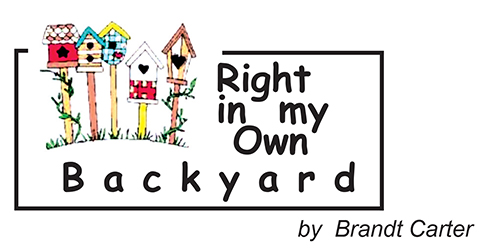
|
Broad Ripple Random Ripplings

The news from Broad Ripple
Brought to you by The Broad Ripple Gazette
(Delivering the news since 2004, every two weeks)

|
| Brought to you by: |

|

|

|

|

|

|
Converted from paper version of the Broad Ripple Gazette (v12n15)
Right in my Own Backyard - Pollination: The Work of Many - by Brandt Carter
posted: Jul. 24, 2015

Pollination: The Work of Many
Plants surrounding our private and public spaces have to be pollinated to reproduce and thrive. Wind and water are major forces behind pollination. In my backyard, I can participate in the process. You can too. Yes, together we can be biotic pollen vectors. If this sounds like advanced science, it's really just basic botany. Yes, we are part of the scheme of life.
Birds and bees are critical to our landscapes and farmlands. Urban bee keepers are encouraging the bee population in our area. Whether the desire to have honey or just to aid vegetable and flower gardens, more gardeners are adding bee keeping to their backyard activities. You may have heard about the bee population collapse. It is a real concern. Nearly "80% of our world's food crops require pollination to set seed. An estimated one out of every three bites of food comes to us through the work of animal pollinators," experts report.
Did you know butterflies and moths pollinate but are not as efficient as bees? Beetles are also major pollen miners and spreaders to 88% of those plants that depend on biotic pollen vectors (organisms that carry or move pollen grains from a plant's anthers to the receptive parts).
Birds and animals also participate in this life-giving process. The hummingbird that visits your feeder also stops at flowers on the way. With each drink, the tiny hummingbird bodies brush against the pollen and take it to another flower. Interestingly, bats also help with pollination. They are the night riders of pollination, beginning their work at dusk and continuing on through the dark. You can also consider dogs, cats, opossums, and raccoons pollinators along with humans. If we all just brush up against flowering plants, we can move the pollen throughout our yard.
You don't have to be an anthecologist (study of pollination) to watch the miracle of pollination. Sit quietly near a garden (Indianapolis Art Center park, the Bill Brink Memorial Garden in Broad Ripple, or your yard) and observe creatures crawling into a flower. Did you see a bee, an ant, a beetle, a butterfly or a hummingbird? What you are witnessing is a life cycle. This sometimes is more awe inspiring than rush of other things happening around us. Yes, you will be watching pollination -a critical process of life.
Brandt Carter, artist, herbalist, and naturalist, owns Backyard Birds at 2374 E. 54th Street. Visit her web site www.feedbackyardbirds.com. Email your bird questions to Brandt@BroadRippleGazette.com
brandt@broadripplegazette.com

|

|

|
| Brought to you by: |

|

|

|
| Brought to you by: |

|

|

|


